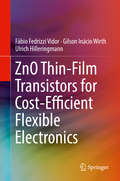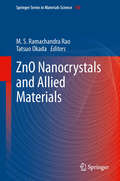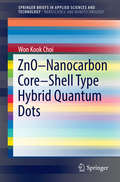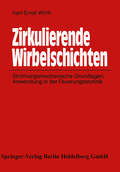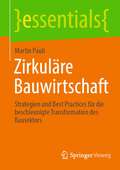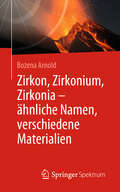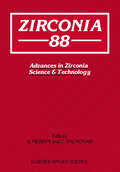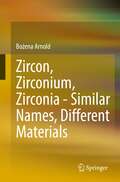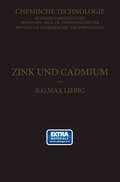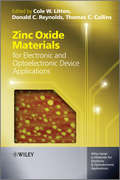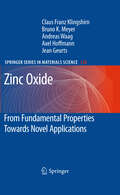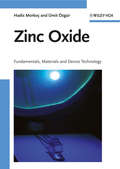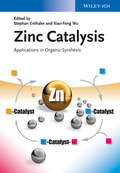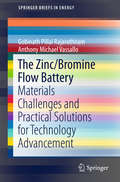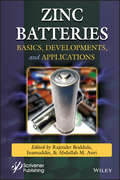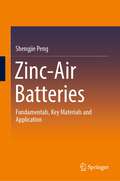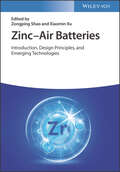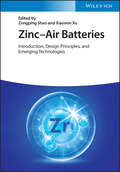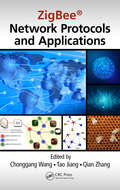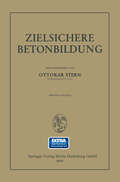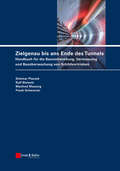- Table View
- List View
ZnO Thin-Film Transistors for Cost-Efficient Flexible Electronics
by Fábio Fedrizzi Vidor Gilson Inácio Wirth Ulrich HilleringmannThis book describes the integration, characterization and analysis of cost-efficient thin-film transistors (TFTs), applying zinc oxide as active semiconductors. The authors discuss soluble gate dielectrics, ZnO precursors, and dispersions containing nanostructures of the material, while different transistor configurations are analyzed with respect to their integration, compatibility, and device performance. Additionally, simple circuits (inverters and ring oscillators) and a complementary design employing (in)organic semiconducting materials are presented and discussed. Readers will benefit from concise information on cost-efficient materials and processes, applied in flexible and transparent electronic technology, such as the use of solution-based materials and dispersion containing nanostructures, as well as discussion of the physical fundamentals responsible for the operation of the thin-film transistors and the non-idealities of the device.
ZnO Nanocrystals and Allied Materials (Springer Series in Materials Science #180)
by M S Ramachandra Rao Tatsuo OkadaZnO has been the central theme of research in the past decade due to its various applications in band gap engineering, and textile and biomedical industries. In nanostructured form, it offers ample opportunities to realize tunable optical and optoelectronic properties and it was also termed as a potential material to realize room temperature ferromagnetism. This book presents 17 high-quality contributory chapters on ZnO related systems written by experts in this field. These chapters will help researchers to understand and explore the varied physical properties to envisage device applications of ZnO in thin film, heterostructure and nanostructure forms.
ZnO-Nanocarbon Core-Shell Type Hybrid Quantum Dots (SpringerBriefs in Applied Sciences and Technology)
by Won Kook ChoiThis book offers a comprehensive overview of ZnO-nano carbon core shell hybrid issues. There is significant interest in metal oxide/nanocarbon hybrid functional materials in the field of energy conversion and storage as electrode materials for supercapacitors, Li ion secondary battery, electrocatalysts for water splitting, and optoelectronic devices such as light emitting diodes and solar photovoltaic cells. Despite efforts to manipulate more uniform metal oxide-nanocarbon nanocomposite structures, they have shown poor performance because they are randomly scattered and non-uniformly attached to the nanocarbon surface. For higher and more effective performance of the hybrid structure, 3D conformal coating on metal oxides are highly desirable.In the first part of the book, the physical and chemical properties of ZnO and nanocarbons and the state-of-the-art in related research are briefly summarized. In the next part, the 3D conformal coating synthetic processes of ZnO templated nanocarbon hybrid materials such as ZnO-graphene,-C60, single-walled (SWCNT) are introduced with the aid of schematic illustrations. Analysis of their chemical bonding and structure are also presented. In the final section, several applications are presented: UV photovoltaic cells and photoelectrochemical anodes for water splitting using ZnO-C60 and ZnO-graphene, white-light-emitting diodes based on ZnO-graphene quantum dots(GQDs), inverted solar cells using ligand-modified ZnO-graphene QDs, and P(VDF-TrFE) copolymer with mixed with nano-ring SWCNT.The book describes how strong anchoring bonds between a ZnO core and carbon nanomaterial shell will ultimately prevail over the main drawbacks of ZnO with high charge recombination and poor electrochemical stability in liquid solutions. Due to the moderate energy states and excellent electric properties of the nanocarbons, ultrafast charge carrier transport from the ZnO core to the nanocarbon shell is guaranteed with the use of the photoluminescence (PL) lifetime measurement.Given the growing interest and significance of future research in optoelectronic and electrochemical devices applications, the contents are very timely. This book is targeted towards researchers looking for highly efficient metal oxide-nanocarbon hybrid functional materials in the fields of nano-optoelectronics, photoelectrochemistry, energy storage and conversion.
Zivilgesellschaft – DIE Herausforderung: GLOBArt Academy 2005 (GLOBArt)
by GlobArtPersönlichkeiten aus Kunst, Wissenschaft, Wirtschaft und Politik erörtern, was Zivilgesellschaft ist, welchen Beitrag sie für die Gesellschaft leistet, welche Herausforderungen sie annimmt. Beispiele aus der Praxis als Motivation zum zivilen Engagement werden vorgestellt, die Europäische Verfassung aus dem Blickwinkel des Bürgers betrachtet, Vergleiche gelebter Zivilgesellschaft in den USA, Europa und Afrika angestellt sowie über die Hol- und Bringschuld von Staat und Bürgern diskutiert. Für ihr ziviles Engagement wurden Freda Meissner-Blau und Caritaspräsident Franz Küberl mit dem GLOBArt Award ausgezeichnet.
Zirkulierende Wirbelschichten: Strömungsmechanische Grundlagen, Anwendung in der Feuerungstechnik
by Karl-Ernst WirthObwohl zirkulierende Wirbelschichten seit 50 Jahren großtechnisch zum Einsatz kommen, steht die wissenschaftliche Durchdringung dieses Verfahrensprinzips erst am Anfang. Bisherige Anwendungen der zirkulierenden Wirbelschicht waren im wesentlichen auf Verfahren mit einem festen Betriebspunkt beschränkt. Erst die Verwendung als Feuerungssystem mit der Forderung nach Teillastfahrweise offenbarte das mangelnde Wissen über die Strömungsvorgänge in zirkulierenden Wirbelschichten. Das vorliegende Buch soll dazu beitragen, diese Wissenslücke zu schließen. Die strömungsmechanischen Grundlagen der zirkulierenden Wirbelschicht wurden vom Autor erarbeitet, und er stellt sie hier erstmals dar. Dabei wird insbesondere gezeigt, welche Auswirkungen die Bauart der zirkulierenden Wirbelschicht auf deren Betriebsweise hat. Hierzu werden dimensionslose Zustandsdiagramme mitgeteilt. Im zweiten Teil des Buches wird ein einfaches Modell der zirkulierenden Wirbelschichtfeuerung erstellt, mit dessen Hilfe wärmetechnische Zustandsdiagramme berechnet werden können. In Verbindung mit den aus den strömungsmechanischen Grundlagen erhaltenen Zustandsdiagrammen können zirkulierende Wirbelschichtfeuerungen ausgelegt und deren Betriebsverhalten analysiert werden.
Zirkuläre Bauwirtschaft: Strategien und Best Practices für die beschleunigte Transformation des Bausektors (essentials)
by Martin PauliDieses Essential fasst prägnant zusammen, warum die Prinzipien der Kreislaufwirtschaft für die Bauwirtschaft im Kontext von Klimawandel und zunehmender Ressourcenknappheit unabdingbar sind. Es gibt Einblicke in Umsetzungsstrategien und Projektbeispiele, beleuchtet die elementaren Methoden zur Messbarkeit von sektorspezifischen CO2-Emissionen und wirft einen systemischen Blick auf die Wertschöpfungskette Bau sowie die Implikationen, Potenziale und Risiken der Umsetzung.
Zirkon, Zirkonium, Zirkonia - ähnliche Namen, verschiedene Materialien
by Bożena ArnoldIm vorliegenden Buch finden Sie viele spannende und oft erstaunliche Informationen über diese außergewöhnlichen und vielfältigen Materialien. Die Darstellung ist im Wesentlichen chronologisch aufgebaut und folgt der Geschichte der Entdeckung dieser Materialien. Dabei werden ihre Eigenschaften und Anwendungsbereiche beschrieben. Das Buch stellt eine Mischung aus Fach- und Sachbuch dar: verständlich für Fachleute und Laien.
Zirconia’88: Advances in Zirconia Science and Technology
by S. Meriani C. PalmonariThis meeting, ZIRCONIA 'SS - Advances in Zirconia Science and Technology, was held within the framework of the 7tb SIMCER - International Symposium on Ceramics (Bologna, December 14-17, 1988) organized by the Italian Ceramic Center of Bologna, with the sponsorship of ENEA and Agip and the endorsement of the American Ceramic Society, and under the auspices of the European Ceramic Society. In the year 1988, the University of Bologna celebrated its 900th Anniversary. ZIRCONIA '88 was one of the celebration events which brought together academics and researchers from allover the world. Under the chairmanship of Prof. C. Palmonari, Director of the Italian Ceramic Center of the University of Bologna, the Organizing Committee consisting of J. Castaing (C.N.R.S. Meudon, France), S. Meriani (University of Trieste, Italy), V. Prodi (Un-iversity of Bologna, Italy) and J. Routbort (U.S. Dept. of Energy, Washington, USA) conducted a conference program of 47 contributions presented to the 220 enrolled Zirconia participants, out of the 775 enlisted within the main SIMCER framework. The aim of ZIRCONIA '88 was to follow the stream of the well known International Conferences on the Science and Technology of zj rconia held in Cleveland, Ohio (1980), Stuttgart, Federal Republic of Germany (1983) and Tokyo, Japan (1986). SIMCER's goal was to bring together not only scientists and engineers directly involved with "advanced" ceramics but also a larger audience connected to the nearby Italian Ceramic District of Sassuolo.
Zircon, Zirconium, Zirconia - Similar Names, Different Materials
by Bożena ArnoldIn this book you will find a lot of exciting and often astonishing information about these extraordinary and diverse materials. The presentation is essentially structured chronologically and follows the history of the discovery of these materials. Their properties and areas of application are described. The book is a mixture of specialist and non-fiction: understandable for experts and laypeople.This book is a translation of the original German 1st edition Zirkon, Zirkonium, Zirkonia - ähnliche Namen, verschiedene Materialien by Bożena Arnold, published by Springer-Verlag GmbH Germany, part of Springer Nature in 2019. The translation was done with the help of artificial intelligence (machine translation by the service DeepL.com). A subsequent human revision was done primarily in terms of content, so that the book will read stylistically differently from a conventional translation. Springer Nature works continuously to further the development of tools for the production of books and on the related technologies to support the authors.
Zink und Cadmium und ihre Gewinnung aus Erzen und Nebenprodukten (Chemische Technologie in Einzeldarstellungen)
by R. G. LiebigDieser Buchtitel ist Teil des Digitalisierungsprojekts Springer Book Archives mit Publikationen, die seit den Anfängen des Verlags von 1842 erschienen sind. Der Verlag stellt mit diesem Archiv Quellen für die historische wie auch die disziplingeschichtliche Forschung zur Verfügung, die jeweils im historischen Kontext betrachtet werden müssen. Dieser Titel erschien in der Zeit vor 1945 und wird daher in seiner zeittypischen politisch-ideologischen Ausrichtung vom Verlag nicht beworben.
Zinc Oxide Materials for Electronic and Optoelectronic Device Applications (Wiley Series In Materials For Electronic And Optoelectronic Applications Ser. #36)
by Peter Capper Safa Kasap Arthur WilloughbyZinc Oxide (ZnO) powder has been widely used as a white paint pigment and industrial processing chemical for nearly 150 years. However, following a rediscovery of ZnO and its potential applications in the 1950s, science and industry alike began to realize that ZnO had many interesting novel properties that were worthy of further investigation. ZnO is a leading candidate for the next generation of electronics, and its biocompatibility makes it viable for medical devices. This book covers recent advances including crystal growth, processing and doping and also discusses the problems and issues that seem to be impeding the commercialization of devices. Topics include: Energy band structure and spintronics Fundamental optical and electronic properties Electronic contacts of ZnO Growth of ZnO crystals and substrates Ultraviolet photodetectors ZnO quantum wells Zinc Oxide Materials for Electronic and Optoelectronic Device Applications is ideal for university, government, and industrial research and development laboratories, particularly those engaged in ZnO and related materials research.
Zinc Oxide Materials for Electronic and Optoelectronic Device Applications (Wiley Series in Materials for Electronic & Optoelectronic Applications #36)
by Peter Capper Safa Kasap Arthur WilloughbyZinc Oxide (ZnO) powder has been widely used as a white paint pigment and industrial processing chemical for nearly 150 years. However, following a rediscovery of ZnO and its potential applications in the 1950s, science and industry alike began to realize that ZnO had many interesting novel properties that were worthy of further investigation. ZnO is a leading candidate for the next generation of electronics, and its biocompatibility makes it viable for medical devices. This book covers recent advances including crystal growth, processing and doping and also discusses the problems and issues that seem to be impeding the commercialization of devices. Topics include: Energy band structure and spintronics Fundamental optical and electronic properties Electronic contacts of ZnO Growth of ZnO crystals and substrates Ultraviolet photodetectors ZnO quantum wells Zinc Oxide Materials for Electronic and Optoelectronic Device Applications is ideal for university, government, and industrial research and development laboratories, particularly those engaged in ZnO and related materials research.
Zinc Oxide: From Fundamental Properties Towards Novel Applications (Springer Series in Materials Science #120)
by Claus F. Klingshirn Andreas Waag Axel Hoffmann Jean GeurtsZinc Oxide: Fundamentals, Materials and Device Technology
by Hadis Morkoç Ümit ÖzgürThis first systematic, authoritative and thorough treatment in one comprehensive volume presents the fundamentals and technologies of the topic, elucidating all aspects of ZnO materials and devices. Following an introduction, the authors look at the general properties of ZnO, as well as its growth, optical processes, doping and ZnO-based dilute magnetic semiconductors. Concluding sections treat bandgap engineering, processing and ZnO nanostructures and nanodevices. Of interest to device engineers, physicists, and semiconductor and solid state scientists in general.
Zinc Catalysis: Applications in Organic Synthesis
by Stephan EnthalerFilling the gap in the market for comprehensive coverage of this hot topic, this timely book covers a wide range of organic transformations, e. g. reductions of unsaturated compounds, oxidation reactions, Friedel-Crafts reactions, hydroamination reactions, depolymerizations, transformations of carbon dioxide, oxidative coupling reactions, as well as C-C, C-N, and C-O bond formation reactions. A chapter on the application of zinc catalysts in total synthesis is also included. With its aim of stimulating further research and discussion in the field, this is a valuable reference for professionals in academia and industry wishing to learn about the latest developments.
Zinc Catalysis: Applications in Organic Synthesis (Catalysis Ser. #Volume 16)
by Stephan Enthaler Xiao-Feng WuFilling the gap in the market for comprehensive coverage of this hot topic, this timely book covers a wide range of organic transformations, e. g. reductions of unsaturated compounds, oxidation reactions, Friedel-Crafts reactions, hydroamination reactions, depolymerizations, transformations of carbon dioxide, oxidative coupling reactions, as well as C-C, C-N, and C-O bond formation reactions. A chapter on the application of zinc catalysts in total synthesis is also included. With its aim of stimulating further research and discussion in the field, this is a valuable reference for professionals in academia and industry wishing to learn about the latest developments.
The Zinc/Bromine Flow Battery: Materials Challenges and Practical Solutions for Technology Advancement (SpringerBriefs in Energy)
by Gobinath Pillai Rajarathnam Anthony Michael VassalloThis book presents a detailed technical overview of short- and long-term materials and design challenges to zinc/bromine flow battery advancement, the need for energy storage in the electrical grid and how these may be met with the Zn/Br system. Practical interdisciplinary pathways forward are identified via cross-comparison and comprehensive review of significant findings from more than 300 published works, with clear in-depth explanations spanning initial RFB development to state-of-the-art research in related systems. Promising strategies described include the use of modern electrochemical techniques to study and optimize physical processes occurring within the system during operation, improving zinc electroplating quality during the charge phase through the strategic use of organic additives, as well as identifying suitable catalysts to optimize the bromine/bromide redox couple. The primary focus is on research and development of novel materials in the areas of electrolyte formulation and multifunctional “smart” electrode surfaces to achieve a higher degree of control over processes at the electrode–electrolyte interface. The strategies suggested in this book are also highly adaptable for use in other similar flow battery systems, while the unique cross-comparative approach makes it a useful reference and source of new ideas for both new and established researchers in the field of energy storage and battery technology.
Zinc Batteries: Basics, Developments, and Applications
by Rajender Boddula Inamuddin Abdullah M. AsiriBattery technology is constantly changing, and the concepts and applications of these changes are rapidly becoming increasingly more important as more and more industries and individuals continue to make “greener” choices in their energy sources. As global dependence on fossil fuels slowly wanes, there is a heavier and heavier importance placed on cleaner power sources and methods for storing and transporting that power. Battery technology is a huge part of this global energy revolution. Zinc batteries are an advantageous choice over lithium-based batteries, which have dominated the market for years in multiple areas, most specifically in electric vehicles and other battery-powered devices. Zinc is the fourth most abundant metal in the world, which is influential in its lower cost, making it a very attractive material for use in batteries. Zinc-based batteries have been around since the 1930s, but only now are they taking center stage in the energy, automotive, and other industries. Zinc Batteries: Basics, Developments, and Applicationsis intended as a discussion of the different zinc batteries for energy storage applications. It also provides an in-depth description of various energy storage materials for Zinc (Zn) batteries. This book is an invaluable reference guide for electrochemists, chemical engineers, students, faculty, and R&D professionals in energy storage science, material science, and renewable energy.
Zinc Batteries: Basics, Development, and Applications
by Inamuddin Rajender Boddula Abdullah M. AsiriBattery technology is constantly changing, and the concepts and applications of these changes are rapidly becoming increasingly more important as more and more industries and individuals continue to make “greener” choices in their energy sources. As global dependence on fossil fuels slowly wanes, there is a heavier and heavier importance placed on cleaner power sources and methods for storing and transporting that power. Battery technology is a huge part of this global energy revolution. Zinc batteries are an advantageous choice over lithium-based batteries, which have dominated the market for years in multiple areas, most specifically in electric vehicles and other battery-powered devices. Zinc is the fourth most abundant metal in the world, which is influential in its lower cost, making it a very attractive material for use in batteries. Zinc-based batteries have been around since the 1930s, but only now are they taking center stage in the energy, automotive, and other industries. Zinc Batteries: Basics, Developments, and Applicationsis intended as a discussion of the different zinc batteries for energy storage applications. It also provides an in-depth description of various energy storage materials for Zinc (Zn) batteries. This book is an invaluable reference guide for electrochemists, chemical engineers, students, faculty, and R&D professionals in energy storage science, material science, and renewable energy.
Zinc-Air Batteries: Fundamentals, Key Materials and Application
by Shengjie PengThis book aims to discuss the cutting-edge materials and technologies for zinc-air batteries. From the perspective of basic research and engineering application, the principle innovation, research progress, and technical breakthrough of key materials such as positive and negative electrodes, electrolytes, and separators of zinc-air batteries are discussed systematically, which can be used to guide and promote the development of zinc-air battery technology. We do believe that our experiences and in-depth discussions would make this book useful for researchers at all levels in the energy area and provide them with a quick way of understanding the development of zinc-air batteries.
Zinc-Air Batteries: Introduction, Design Principles and Emerging Technologies
by Zongping Shao Xiaomin XuZinc–Air Batteries Authoritative and comprehensive resource covering foundational knowledge of zinc–air batteries as well as their practical applications Zinc–Air Batteries provides a comprehensive understanding of the history and development of Zn–air batteries, with a systematic overview of components, design, and device innovation, along with recent advances in the field, especially with regards to the cathode catalyst design made by cutting-edge materials, engineering processes, and technologies. In particular, design principles regarding the key components of Zn–air batteries, ranging from air cathode, to zinc anode, and to electrolyte, are emphasized. Furthermore, industrial developments of Zn–air batteries are discussed and emerging new designs of Zn–air batteries are also introduced. The authors argue that designing advanced Zn–air battery technologies is important to the realization of efficient energy storage and conversion—and, going further, eventually holds the key to a sustainable energy future and a carbon-neutral goal. Edited and contributed to by leading professionals and researchers in the field, Zinc–Air Batteries also contains information regarding: Design of oxygen reduction catalysts in primary zinc–air batteries, including precious metals, single-atoms, carbons, and transition metal oxides Design of bifunctional oxygen catalysts in rechargeable zinc–air batteries, covering specific oxygen redox reactions and catalyst candidates Design of three-dimensional air cathode in zinc–air batteries, covering loading of carbon-based and transition metal catalysts, plus design of the three-phase interface Design of electrolyte for zinc–air batteries, including liquid electrolytes (e.g., alkaline) and gel polymer electrolytes (e.g., PVA hydrogel) For students, researchers, and instructors working in battery technologies, materials science, and electrochemistry, and for industry and government representatives for decision making associated with energy and transportation, Zinc–Air Batteries summarizes the research results on Zn–air batteries and thereby helps researchers and developers to implement the technology in practice.
Zinc-Air Batteries: Introduction, Design Principles, and Emerging Technologies
by Zongping Shao Xiaomin XuZinc–Air Batteries Authoritative and comprehensive resource covering foundational knowledge of zinc–air batteries as well as their practical applications Zinc–Air Batteries provides a comprehensive understanding of the history and development of Zn–air batteries, with a systematic overview of components, design, and device innovation, along with recent advances in the field, especially with regards to the cathode catalyst design made by cutting-edge materials, engineering processes, and technologies. In particular, design principles regarding the key components of Zn–air batteries, ranging from air cathode, to zinc anode, and to electrolyte, are emphasized. Furthermore, industrial developments of Zn–air batteries are discussed and emerging new designs of Zn–air batteries are also introduced. The authors argue that designing advanced Zn–air battery technologies is important to the realization of efficient energy storage and conversion—and, going further, eventually holds the key to a sustainable energy future and a carbon-neutral goal. Edited and contributed to by leading professionals and researchers in the field, Zinc–Air Batteries also contains information regarding: Design of oxygen reduction catalysts in primary zinc–air batteries, including precious metals, single-atoms, carbons, and transition metal oxides Design of bifunctional oxygen catalysts in rechargeable zinc–air batteries, covering specific oxygen redox reactions and catalyst candidates Design of three-dimensional air cathode in zinc–air batteries, covering loading of carbon-based and transition metal catalysts, plus design of the three-phase interface Design of electrolyte for zinc–air batteries, including liquid electrolytes (e.g., alkaline) and gel polymer electrolytes (e.g., PVA hydrogel) For students, researchers, and instructors working in battery technologies, materials science, and electrochemistry, and for industry and government representatives for decision making associated with energy and transportation, Zinc–Air Batteries summarizes the research results on Zn–air batteries and thereby helps researchers and developers to implement the technology in practice.
ZigBee Network Protocols and Applications
Compared with other wireless communication technologies, such as Bluetooth, WiFi, and UWB, ZigBee is a far more reliable, affordable, and energy-efficient option. It is also the only global wireless communication standard for easily deployed, low-power consumption products.ZigBee Network Protocols and Applications provides detailed descriptions of
Zielsichere Betonbildung: Auf der Grundlage der Versuchsberichte des Unterausschusses für Zielsichere Betonbildung (UABb) im Österr. Eisenbetonausschusse
by Ottokar SternDieser Buchtitel ist Teil des Digitalisierungsprojekts Springer Book Archives mit Publikationen, die seit den Anfängen des Verlags von 1842 erschienen sind. Der Verlag stellt mit diesem Archiv Quellen für die historische wie auch die disziplingeschichtliche Forschung zur Verfügung, die jeweils im historischen Kontext betrachtet werden müssen. Dieser Titel erschien in der Zeit vor 1945 und wird daher in seiner zeittypischen politisch-ideologischen Ausrichtung vom Verlag nicht beworben.
Zielgenau bis ans Ende des Tunnels: Handbuch für die Bauvorbereitung, Vermessung und Bauüberwachung von Schildvortrieben
by Dietmar Placzek Rolf Bielecki Manfred Messing Frank SchwarzerDamit der fertige Tunnel am Ende seine Funktion erfüllen kann, muss er exakt so liegen, wie er geplant wurde. Einfluss auf die Vortriebsgenauigkeit haben Trassen- und Gradientenplanung, Baugrund- und Grundwasserverhältnisse, das gewählte Vortriebsverfahren, Einwirkungen und Widerstände auf die Vortriebsmaschine sowie die begleitende Bauüberwachung und Kontrolle. Das Handbuch ist Grundlage für die Bauvorbereitung, die Vermessung und Bauüberwachung von Schildvortrieben und gilt gleichermaßen für Rohr- und Tübbingvortriebe, die mit gesteuerten Schildmaschinen durchgeführt werden. Bauherren, Planer, Prüfer und Ausführenden werden dieses Handbuch als technischen Leitfaden für einen sicheren und zielgenauen Vortrieb nutzen. Das Buch ist darüber hinaus auch als Lehrbuch im Rahmen der Aus- und Weiterbildung geeignet.
